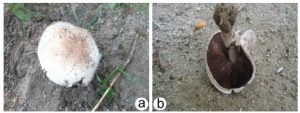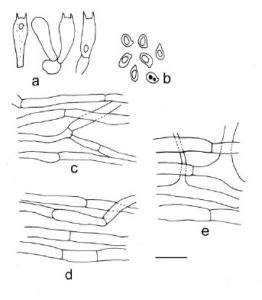Agaricus californicus Peck, Bull. Torrey bot. Club 22: 203 (1895) Index Fungorum number: IF 220273
Synonymy: Fungus californicus (Peck) Kuntze, Revis. gen. pl. (Leipzig) 3(2): 479 (1898)
Pileus 9.6 cm wide, initially convex, then expanding becoming broadly convex to plane, yellowish cream, scales present, flesh thick. Gills free, sub–distant to crowded, dark brown. Stipe 7.5 cm long and 1.2 cm wide, equal, central, bulbous from the base. Annulus present, thick, membranous, persistent with patches.
Basidia 19.2–22.4 × 4.8–6.4 μm, clavate, hyaline. Sterigmata 1.6–2.4 μm long. Basidiospores 4.8–7.2 × 4.0–5.6 μm, avL=6.0, avW=4.8, Q=1.2–1.28, hyaline, thick walled, elliptical, apiculate, dark olive green to pale green (same colour in Melzer’s reagent), inamyloid. Spore print chocolate brown. Pileus and stipe context hyphae 3.2–4.8 μm and 4.0–5.6 μm wide respectively, hyaline, thin walled, septate, unbranched. Annulus hyphae 6.4–8.8 μm wide, hyaline, septate, branched.
Collection examined – India, Jammu & Kashmir, Jammu, Bajalta, humicolous, 17 Jul 2015, Roshi Sharma & Y.P. Sharma, HBJU 405.
Distribution – Earlier reported from North America.
Remarks – The current species constitutes a new record for India. The macroscopic and microscopic details of the above described specimen are in conformity with that given by Arora (1986). Typically found solitary to scattered, the species has many morphological similarities with Agaricus xanthodermus, A. campestris and A. bisporus but can be set apart by the presence of persistent membranous annulus, whitish gills when young and slight phenolic odour.
FIGURE. a Pileus surface view of Agaricus californicus. b Ventral surface view of A. californicus showing hymenium and stipe.

FIGURE. Agaricus californicus a) basidia b) basidiospores c) pileus context hyphae d) stipe context hyphae e) annulus hyphae. Scale bars: a–e = 10 μm.

